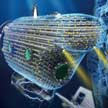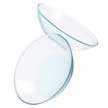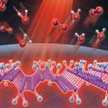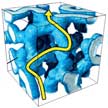Showing Spotlights 793 - 800 of 2879 in category All (newest first):
 Given the vast, and still rising, cost of optical lithography tools, researchers have considered alternative patterning technologies such as electron beam lithography (EBL), and nanoimprint technology (NIL) in order to enable the manufacturing of next-generation integrated circuits, flash memory, and hard disk drives. Now that the length scales attainable by top-down lithography are approaching that of bottom-up self-assembly found in polymers and small molecules, scientists are increasingly looking at bottom-up patterning technologies based on self-assembly.
Given the vast, and still rising, cost of optical lithography tools, researchers have considered alternative patterning technologies such as electron beam lithography (EBL), and nanoimprint technology (NIL) in order to enable the manufacturing of next-generation integrated circuits, flash memory, and hard disk drives. Now that the length scales attainable by top-down lithography are approaching that of bottom-up self-assembly found in polymers and small molecules, scientists are increasingly looking at bottom-up patterning technologies based on self-assembly.
Mar 9th, 2018
 Due to its fascinating properties, black phosphorus (BP) has demonstrated appealing potential for not only building (opto)electronic devices, but also in many other areas such as lithium-ion batteries, solar cells, sensors, thermoelectric devices, supercapacitors, and phototherapy. Researchers now have demonstrated that modifying BP with metal ions solved its previous instability problem, which hindered the practical application of BP in electronics and optoelectronics; while at the same time further enhancing the original superior transport properties.
Due to its fascinating properties, black phosphorus (BP) has demonstrated appealing potential for not only building (opto)electronic devices, but also in many other areas such as lithium-ion batteries, solar cells, sensors, thermoelectric devices, supercapacitors, and phototherapy. Researchers now have demonstrated that modifying BP with metal ions solved its previous instability problem, which hindered the practical application of BP in electronics and optoelectronics; while at the same time further enhancing the original superior transport properties.
Mar 7th, 2018
 Enzymatic biofuel cells (EBFCs) are bioelectronic devices that utilize enzymes as the electrocatalysts to catalyze the oxidation of fuel and/or the reduction of oxygen or peroxide for energy conversion to electricity. EBFCs have already been demonstrated as wearable epidermal tattoo biosensors and in new work, researchers report the fabrication flexible EBFCs with flexible nanoporous gold electrodes that were modified with lactate oxidase and bilirubin oxidase for use as a lactate/O2 biofuel cell.
Enzymatic biofuel cells (EBFCs) are bioelectronic devices that utilize enzymes as the electrocatalysts to catalyze the oxidation of fuel and/or the reduction of oxygen or peroxide for energy conversion to electricity. EBFCs have already been demonstrated as wearable epidermal tattoo biosensors and in new work, researchers report the fabrication flexible EBFCs with flexible nanoporous gold electrodes that were modified with lactate oxidase and bilirubin oxidase for use as a lactate/O2 biofuel cell.
Mar 6th, 2018
 For the first time, liquid-phase exfoliation (LPE) - a widely explored technique to obtain two-dimensional (2D) layered nano-architectures - has been successfully used to exfoliate tellurium, a non-layered material. The resulting 2D Te nanosheets exhibit excellent photoresponse behavior from the UV to the visible regime in association with strong time and cycle stability for on/off switching behavior. This intriguing finding could help in the search for other 2D materials for innovative applications.
For the first time, liquid-phase exfoliation (LPE) - a widely explored technique to obtain two-dimensional (2D) layered nano-architectures - has been successfully used to exfoliate tellurium, a non-layered material. The resulting 2D Te nanosheets exhibit excellent photoresponse behavior from the UV to the visible regime in association with strong time and cycle stability for on/off switching behavior. This intriguing finding could help in the search for other 2D materials for innovative applications.
Mar 5th, 2018
 Recently, a new member has been introduced to the family of two-dimensional (2D) materials: phosphorene. Phosphorene has attracted much attention because of its tunable direct band gap and superior carrier mobility, but unfortunately phosphorene is subjected to oxidation and degradation under ambient conditions. Now, researchers have reported a facile pathway in obtaining and stabilizing phosphorene through a one-step, ionic liquid-assisted electrochemical exfoliation and synchronous fluorination process. This strategy enabled a novel phosphorene derivative to be discovered - fluorinated phosphorene, which exhibits air-stable photo-thermal properties.
Recently, a new member has been introduced to the family of two-dimensional (2D) materials: phosphorene. Phosphorene has attracted much attention because of its tunable direct band gap and superior carrier mobility, but unfortunately phosphorene is subjected to oxidation and degradation under ambient conditions. Now, researchers have reported a facile pathway in obtaining and stabilizing phosphorene through a one-step, ionic liquid-assisted electrochemical exfoliation and synchronous fluorination process. This strategy enabled a novel phosphorene derivative to be discovered - fluorinated phosphorene, which exhibits air-stable photo-thermal properties.
Mar 2nd, 2018
 A popular structure for the development of nanodelivery systems are hollow tubular nanoparticles. In new work, researchers show that a hydrogel can be confined within the cavity of halloysite nanotubes (HNTs) by means of an easy strategy. The alginate network inside the HNTs cavity can be triggered by chemical stimuli (by calcium chelators) altering the kinetics, which results in the release of the cargo. This shows that halloysite with tunable hydrophilic/hydrophobic interfaces can act as nanotemplate for the synthesis of drug delivery systems based on biopolymer hydrogels.
A popular structure for the development of nanodelivery systems are hollow tubular nanoparticles. In new work, researchers show that a hydrogel can be confined within the cavity of halloysite nanotubes (HNTs) by means of an easy strategy. The alginate network inside the HNTs cavity can be triggered by chemical stimuli (by calcium chelators) altering the kinetics, which results in the release of the cargo. This shows that halloysite with tunable hydrophilic/hydrophobic interfaces can act as nanotemplate for the synthesis of drug delivery systems based on biopolymer hydrogels.
Mar 1st, 2018
 Finding low-cost solid materials capable of efficiently and safely replacing liquid electrolytes in lithium-ion batteries has been a considerable research interest over the past years. Of the various types of solid electrolytes that have been developed so far, composite polymer electrolytes exhibit acceptable Li-ion conductivity due to the interaction between nanofillers and polymer. By fabricating a pre-percolated network of ceramic filler instead of distributing particles in polymer, a 3D interconnected ceramic framework provides continuous pathways for ion conduction. This novel method will help to develop composite materials in a different but much improved way than conventional particle distributions.
Finding low-cost solid materials capable of efficiently and safely replacing liquid electrolytes in lithium-ion batteries has been a considerable research interest over the past years. Of the various types of solid electrolytes that have been developed so far, composite polymer electrolytes exhibit acceptable Li-ion conductivity due to the interaction between nanofillers and polymer. By fabricating a pre-percolated network of ceramic filler instead of distributing particles in polymer, a 3D interconnected ceramic framework provides continuous pathways for ion conduction. This novel method will help to develop composite materials in a different but much improved way than conventional particle distributions.
Feb 28th, 2018
 As a new member of the two-dimensional (2D) nanomaterial family, black phosphorus (BP) has attracted considerable attention in biomedicine, due to its unique physicochemical properties as well as excellent biocompatibility. Researchers have now demonstrated a novel concept of light activation of BP hydrogel to release drugs for cancer therapy. This BP hydrogel is comprised of BP nanosheets as a photosensitizer and hydrogel as a hydrophilic container for drugs. After injection, these nanosheets convert light to thermal energy when exposed to laser irradiation, leading to heating of the hydrogel matrix.
As a new member of the two-dimensional (2D) nanomaterial family, black phosphorus (BP) has attracted considerable attention in biomedicine, due to its unique physicochemical properties as well as excellent biocompatibility. Researchers have now demonstrated a novel concept of light activation of BP hydrogel to release drugs for cancer therapy. This BP hydrogel is comprised of BP nanosheets as a photosensitizer and hydrogel as a hydrophilic container for drugs. After injection, these nanosheets convert light to thermal energy when exposed to laser irradiation, leading to heating of the hydrogel matrix.
Feb 27th, 2018
 Given the vast, and still rising, cost of optical lithography tools, researchers have considered alternative patterning technologies such as electron beam lithography (EBL), and nanoimprint technology (NIL) in order to enable the manufacturing of next-generation integrated circuits, flash memory, and hard disk drives. Now that the length scales attainable by top-down lithography are approaching that of bottom-up self-assembly found in polymers and small molecules, scientists are increasingly looking at bottom-up patterning technologies based on self-assembly.
Given the vast, and still rising, cost of optical lithography tools, researchers have considered alternative patterning technologies such as electron beam lithography (EBL), and nanoimprint technology (NIL) in order to enable the manufacturing of next-generation integrated circuits, flash memory, and hard disk drives. Now that the length scales attainable by top-down lithography are approaching that of bottom-up self-assembly found in polymers and small molecules, scientists are increasingly looking at bottom-up patterning technologies based on self-assembly.
 Subscribe to our Nanotechnology Spotlight feed
Subscribe to our Nanotechnology Spotlight feed





